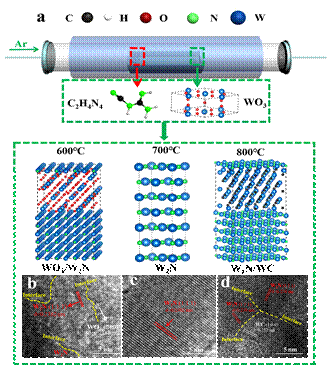| Interfacial Engineering of W2N/WC Heterostructures Derived from Solid‐State Synthesis: A Highly Efficient Trifunctional Electrocatalyst for ORR, OER, and HER |
| From: PublishDate:2020-07-31 Hits: |
Interfacial engineering of the electrocatalysts has been emerging as one of the most effective methods to improve activity, selectivity and the stability during the electrocatalysis.Conventional strategies to construct the interface of two different components adopt the epitaxial growth method in solution conditions, in which the crystal face of substrate and epitaxial interfaces should be exactly controlled. Herein, Guo and Qu’s group presents a facile solid-state synthesis strategy to construct the interface engineering of W2N/WC heterostructures. Their research has been published on February 14th, 2020 in Advanced Materials.
The synchrotron sources in Beijing have helped the team to probe the electronic structure and coordination environment of single atom catalysts. The EXAFS analysis shows the W atoms coordinate with carbon atom, nitrogen atom and no metal bond (W-W) can be observed, which show the formation of W2N/WC heterostructures. These results show W2N/WC heterostructures by a facile solid-state synthesis strategy This highly efficient and energy-saving strategy is beneficial for promoting the large-scale production of interfacial engineering of catalysts. Article: Jinxiang Diao, Yunteng Qu, Yu Qiu, Shuangquan Liu, Weitao Wang, Kai Chen, Hailong Li, Wenyu Yuan, Xiaohui Guo. Interfacial Engineering of W2N/WC Heterostructures Derived from Solid‐State Synthesis: A Highly Efficient Trifunctional Electrocatalyst for ORR, OER, and HER, Advanced Materials, 2020, 1905679. |
|
|
| Chinese
- Metal-free efficient photocatalyst for stable visible water splitting——Top ten major scientific progresses in China in 2015
- The nano-resolution imaging platform was awarded the first rate prize of Beijing Science and Technology in 2014
- Beamline 1W1 of BSRF started to runoperate in the couplingparasitic mode of BEPCII
- Synthesis of High Performance Polymer Materials for Field Effect-Transistors
- Surfactant molecular aggregates in green solvents
- GIXRD has played an important role in the characterization of organic thin-film transistors
Science Highlights
Home /
Copyright © 2011 - 2012 Beijing Synchrotron Radiation Facility


